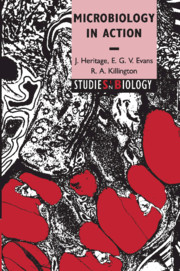Book contents
- Frontmatter
- Contents
- Preface
- 1 The microbiology of soil and of nutrient cycling
- 2 Plant–microbe interactions
- 3 The microbiology of drinking water
- 4 Microbial products
- 5 Food microbiology
- 6 The human commensal flora
- 7 Microbial infections
- 8 Chemotherapy and antibiotic resistance
- Further reading
- Glossary
- Index
4 - Microbial products
Published online by Cambridge University Press: 05 June 2012
- Frontmatter
- Contents
- Preface
- 1 The microbiology of soil and of nutrient cycling
- 2 Plant–microbe interactions
- 3 The microbiology of drinking water
- 4 Microbial products
- 5 Food microbiology
- 6 The human commensal flora
- 7 Microbial infections
- 8 Chemotherapy and antibiotic resistance
- Further reading
- Glossary
- Index
Summary
Glancing through the contents of this book you could easily be forgiven for thinking that microbes were mostly malign, the cause of destruction, disease and death. Indeed, because of the vital importance of the control of infectious diseases, an enormous effort has been directed towards the medical applications of microbiology. Not even Louis Pasteur was lured into a study of microbiology with the intention of ridding the world of disease, as he later aspired to do. Rather, he was appointed to solve an economic and industrial problem threatening to ruin France.
Pasteur started his professional life as a chemist. As a young man, he had found that when polarised light is shone through solutions of organic compounds derived from living organisms the beam is either diverted to the left (laevo-rotatory) or to the right (dextro-rotatory). When organic compounds are synthesised in vitro, no such rotation is seen. He explained this phenomenon by showing that the L-molecules and the L-molecules were optical isomers. In nature typically only one isomeric form is produced or used by organisms. There is a notable exception to this. The bacterial cell wall contains peptidoglycan, a polymer incorporating sugars and both L- and L-amino acids. When organic chemicals are synthesised in test tubes, however, there is an equal chance that either isomer will be made. Because of the reputation gained from this work, in 1854 Pasteur was invited to the University of Lille to study the problem of beer spoilage.
- Type
- Chapter
- Information
- Microbiology in Action , pp. 54 - 72Publisher: Cambridge University PressPrint publication year: 1999



